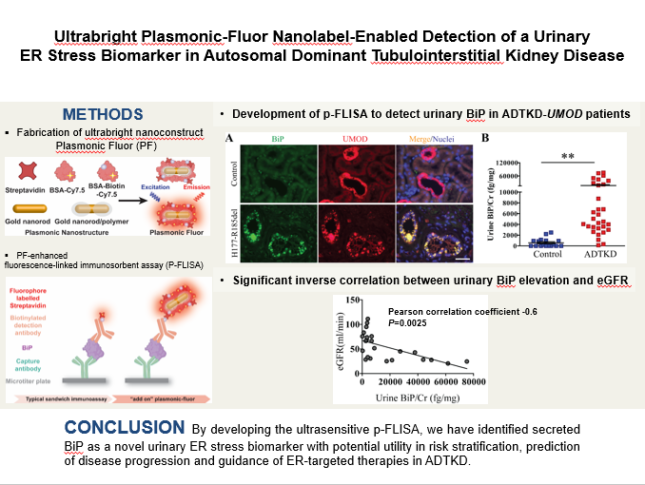WashU Nephrology researchers are part of a group of scientists who have used a new technique that significantly boosts detection and quantification of low-abundance molecular biomarkers in urine to study an underdiagnosed cause of kidney disease.

Yeawon Kim, a member of the Y. Maggie Chen Lab, is first author of the study titled “Ultrabright Plasmonic-Fluor Nanolabel-Enabled Detection of a Urinary ER Stress Biomarker in Autosomal Dominant Tubulointerstitial Kidney Disease (ADTKD),”published, in the American Journal of Physiology – Renal Physiology as an Innovative Methodology article (authors: Yeawon Kim, Zheyu Wang, Chuang Li, Kendrah Kidd, Yixuan Wang, Bryce Johnson, Stanislav Kmoch, Jeremiah Morrissey, Anthony Bleyer, Jeremy Duffield, Srikanth Singamaneni, and Ying Maggie Chen).
The article is highlighted on the AJP-Renal Physiology Facebook page.
ADTKD – uromodulin (UMOD) is associated with a slow and unpredictable loss of kidney function. The lack of ultrasensitive bioanalytical tools has hindered discovery of low abundant urinary biomarkers in ADTKD and has made it impossible to conduct interventional clinical trials.
Kim and her colleagues were the first to discover that immunoglobulin heavy chain-binding protein (BiP), an endoplasmic reticulum (ER) chaperone, can serve as a urinary ER stress biomarker in kidney disease, which was patented in 2018 (US. Patent number 10,156,564).
The study is an application of the superbright nanosensor, plasmonic fluor (PF) nanoconstruct invented by Srikanth Singamaneni, PhD, Lilyan & E. Lisle Hughes Professor, WashU McKelvey School of Engineering. The construct is an ‘add-on’ label for a broad range of bioassays and improves signal-to-noise ratio and dynamic range without altering workflow and readout devices. Analysis using PF enhanced fluorescence linked immunosorbent assay (P-FLISA) demonstrated that secreted BiP is an early urinary ER stress biomarker in ADTKD-UMOD.
“We utilized an ultrasensitive bioanalytical tool to measure urinary BiP levels in ADTKD-UMOD patients for the future goal of risk stratification, disease monitoring, and evaluation of ER-targeted therapies in ADTKD,” says Kim. “The state-of-the-art nanotechnology may accelerate development of more novel biomarkers for ADTKD and other kidney diseases in an easy-to-implement manner.”
Article co-author Jeremiah Morrissey, PhD, Research Professor, WashU Anesthesiology, and former member of the our Division, says, “The substitution of plasmonic-fluor allows detection of low abundance biomarkers of health and disease not attainable by conventional colorimetric- or fluorescent-based assays.”
The study was led by Dr. Maggie Chen. To learn more about her group’s research visit the Y. Maggie Chen Lab and our Nephrology News articles here and here. For more information on Singamaneni’s research see the Singamaneni Lab website.